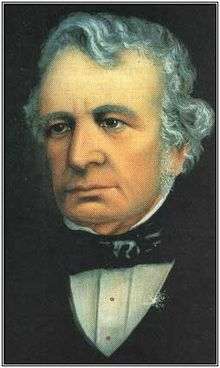George William Francis
George William Francis (1800–9 August 1865) was an English botanical and general science writer. An emigrant to the colony of South Australia in 1849, he made a reputation there as a horticulturalist, becoming the first director of the Adelaide Botanic Garden in 1860.

Life
Born in London, Francis emigrated to Australia for improved prospects of supporting his family; he arrived in the Louisa Baillie 2 September 1849. Shortly he took over the old botanical garden of Adelaide, north of the Torrens River, as a tenant. Subsequently he was appointed director of the Adelaide Botanic Garden, a position he held for the rest of his life.[1]
Francis died after a long illness, of dropsy on 9 August 1865 and was buried the next day. He left a widow and ten children.[1]
Legacy
- The establishment of much of the garden, the pagoda and the first botanical museum in Adelaide, in the Adelaide Botanic Garden.
- Hakea francisiana, an Australian shrub that grows to 4 metres (13 ft), is named after him.[2]
Works
Francis published:[1]
- Catalogue of British Plants and Ferns, 1835; 5th edition, 1840.
- Analysis of British Ferns, 1837; 5th edition, 1855.
- Little English Flora, 1839.
- Grammar of Botany, 1840.
- Chemical Experiments, 1842, abridged by W. White, 1851, and republished as Chemistry for Students.
- Favourites of the Flower Garden, 1844.
- Manual of Practical Levelling for Railways and Canals, 1846.
- Art of Modelling Wax Flowers, 1849.
- Electrical Experiments, 8th edition, 1855.
- Dict. Practical Receipts, new edition, 1857.
- Acclimatisation of Animals and Plants, Royal Society, South Australia, 1862.
Francis also edited the first five volumes of the Magazine of Science and School of Arts, 1840–5.[1]
Notes
- Stephen, Leslie, ed. (1889). . Dictionary of National Biography. 20. London: Smith, Elder & Co.
- "Hakea francisiana". Australian Native Plants Society. August 2008. Retrieved 14 October 2018.
- IPNI. Francis.
Further reading
- Peake, Althaea (2015). "Francis, George William (1800–1865)". People Australia. People Australia, National Centre of Biography, Australian National University.
- "Francis, George William (1800 - 1865)". Council of Heads of Australasian Herbaria. Australian Government. 2015.
- Council of Heads of Australasian Herbaria Australian National Herbarium Biography, Francis, George William (1800-1865).
- Attribution
![]()
External links
- Mennell, Philip (1892). . The Dictionary of Australasian Biography. London: Hutchinson & Co. p. 172 – via Wikisource.